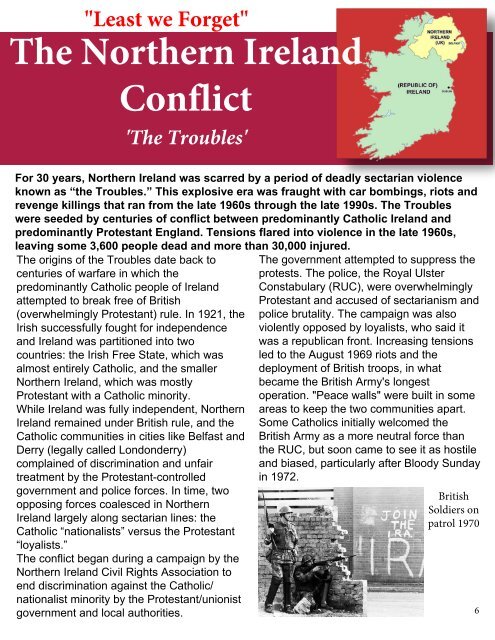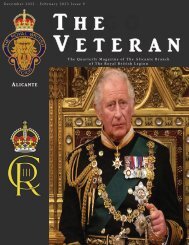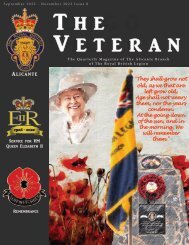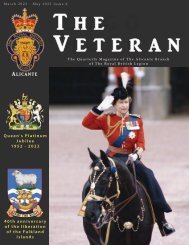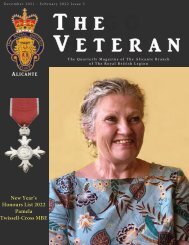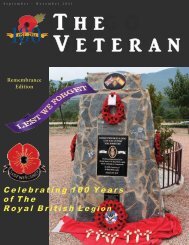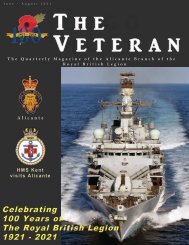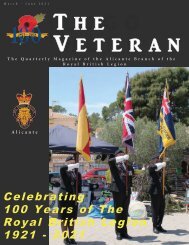The Veteran Issue 7
The Quarterly Magazine of the Alicante Branch of the Royal British Legion, issue 7 September 2022
The Quarterly Magazine of the Alicante Branch of the Royal British Legion, issue 7 September 2022
Create successful ePaper yourself
Turn your PDF publications into a flip-book with our unique Google optimized e-Paper software.
"Least we Forget"<br />
<strong>The</strong> Northern Ireland<br />
Conflict<br />
'<strong>The</strong> Troubles'<br />
For 30 years, Northern Ireland was scarred by a period of deadly sectarian violence<br />
known as “the Troubles.” This explosive era was fraught with car bombings, riots and<br />
revenge killings that ran from the late 1960s through the late 1990s. <strong>The</strong> Troubles<br />
were seeded by centuries of conflict between predominantly Catholic Ireland and<br />
predominantly Protestant England. Tensions flared into violence in the late 1960s,<br />
leaving some 3,600 people dead and more than 30,000 injured.<br />
<strong>The</strong> origins of the Troubles date back to<br />
centuries of warfare in which the<br />
predominantly Catholic people of Ireland<br />
attempted to break free of British<br />
(overwhelmingly Protestant) rule. In 1921, the<br />
Irish successfully fought for independence<br />
and Ireland was partitioned into two<br />
countries: the Irish Free State, which was<br />
almost entirely Catholic, and the smaller<br />
Northern Ireland, which was mostly<br />
Protestant with a Catholic minority.<br />
While Ireland was fully independent, Northern<br />
Ireland remained under British rule, and the<br />
Catholic communities in cities like Belfast and<br />
Derry (legally called Londonderry)<br />
complained of discrimination and unfair<br />
treatment by the Protestant-controlled<br />
government and police forces. In time, two<br />
opposing forces coalesced in Northern<br />
Ireland largely along sectarian lines: the<br />
Catholic “nationalists” versus the Protestant<br />
“loyalists.”<br />
<strong>The</strong> conflict began during a campaign by the<br />
Northern Ireland Civil Rights Association to<br />
end discrimination against the Catholic/<br />
nationalist minority by the Protestant/unionist<br />
government and local authorities.<br />
<strong>The</strong> government attempted to suppress the<br />
protests. <strong>The</strong> police, the Royal Ulster<br />
Constabulary (RUC), were overwhelmingly<br />
Protestant and accused of sectarianism and<br />
police brutality. <strong>The</strong> campaign was also<br />
violently opposed by loyalists, who said it<br />
was a republican front. Increasing tensions<br />
led to the August 1969 riots and the<br />
deployment of British troops, in what<br />
became the British Army's longest<br />
operation. "Peace walls" were built in some<br />
areas to keep the two communities apart.<br />
Some Catholics initially welcomed the<br />
British Army as a more neutral force than<br />
the RUC, but soon came to see it as hostile<br />
and biased, particularly after Bloody Sunday<br />
in 1972.<br />
British<br />
Soldiers on<br />
patrol 1970<br />
6


